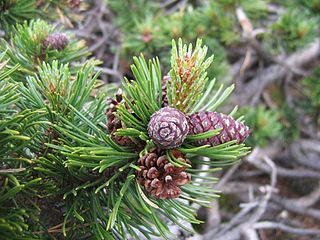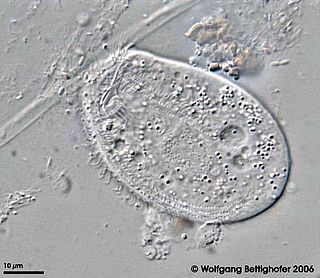
Selaginella is the sole genus of vascular plants in the family Selaginellaceae, the spikemosses or lesser clubmosses.

Pinus mugo, known as bog pine, creeping pine, dwarf mountain pine, mugo pine, mountain pine, scrub mountain pine, or Swiss mountain pine, is a species of conifer, native to high elevation habitats from southwestern to Central Europe and Southeast Europe.
Heliamphora uncinata is a species of Marsh Pitcher Plant endemic to Venezuela. This species of carnivorous plant is known as a pitcher plant. Individuals use tube like leaves to trap insects that slip into the bottom. At the bottom of the "pitcher" there are digestive juices which slowly digest the prey item to give the plant additional nutrients. The pitchers of this species are around 25–35 cm long, and are 8–10 cm wide at the opening. The pitcher mouth is circular in shape and the back is raised to form the lid. It is known only from the type collection, which was made in a narrow canyon on Amurí-tepui. There it grows at an elevation of approximately 1850 m on sandstone cliff faces in shady conditions. It is also found in humus pockets and cracks at this location. The only other species in the genus known to have a similar growth habit is H. exappendiculata. These two taxa also share a number of morphological features and appear to be closely related. These shared morphological features include: the shape of pitchers, the general growth pattern, and appearance of nectaries.

Selaginella uncinata, the blue spikemoss, peacock moss, peacock spikemoss, or spring blue spikemoss, is a species of plant in the Selaginellaceae family.

Cavolinia tridentata is a species of sea butterflies, floating and swimming sea snails or sea slugs, pelagic marine gastropod molluscs in the family Cavoliniidae.

Chilodonella uncinata is a single-celled organism of the ciliate class of alveoles. As a ciliate, C. uncinata has cilia covering its body and a dual nuclear structure, the micronucleus and macronucleus. Unlike some other ciliates, C. uncinata contains millions of minichromosomes in its macronucleus while its micronucleus is estimated to contain 3 chromosomes. Childonella uncinata is the causative agent of Chilodonelloza, a disease that affects the gills and skin of fresh water fish, and may act as a facultative parasite of mosquito larva.

Melaleuca uncinata, commonly known as broombush, broom honeymyrtle or brushwood, is a plant in the paperbark family native to southern Australia. It is harvested from the wild, and grown in plantations, for broombush fencing. The Noongar names for the plant are kwytyat and yilbarra.

Uncinia uncinata, the Hawai'i birdcatching sedge, hook grass, hook sedge, bastard grass, kamu or matau-a-maui, is a species of flowering plant in the sedge family, Cyperaceae.

Eucalyptus uncinata, commonly known as the hook-leaved mallee, is a species of mallee that is endemic to the southwest of Western Australia. It has smooth bark, lance-shaped adult leaves, flower buds arranged in groups of nine to thirteen, creamy white flowers and barrel-shaped to oval or cylindrical fruit.

Osmia uncinata, the pinewood mason bee, is a species of solitary bee from the family Megachilidae It is an Arctic-alpine species which is found in the northern Palearctic, in the United Kingdom it is a Biodiversity Action Plan priority species.

Rudall Conservation Park is a protected area in the Australian state of South Australia located on the Eyre Peninsula in the gazetted locality of Rudall about 18 kilometres (11 mi) west of the town centre in Cleve.
Calytrix uncinata is a species of plant in the myrtle family Myrtaceae that is endemic to Western Australia.
Pyrgocorypha uncinata, the hook-faced conehead, is a species of conehead in the family Tettigoniidae. It is found in North America.
Epichloë uncinata is a hybrid asexual species in the fungal genus Epichloë.
Stelis uncinata is a species of orchid plant and is native to Costa Rica.

Cavolinia globulosa is a species of gastropod in the family Cavoliniidae.

Cavolinia inflexa is a species of gastropod in the family Cavoliniidae.
Cavolinia labiata is a species of gastropod in the family Cavoliniidae.
Cavolinia pachysoma is a species of gastropod in the family Cavoliniidae.












